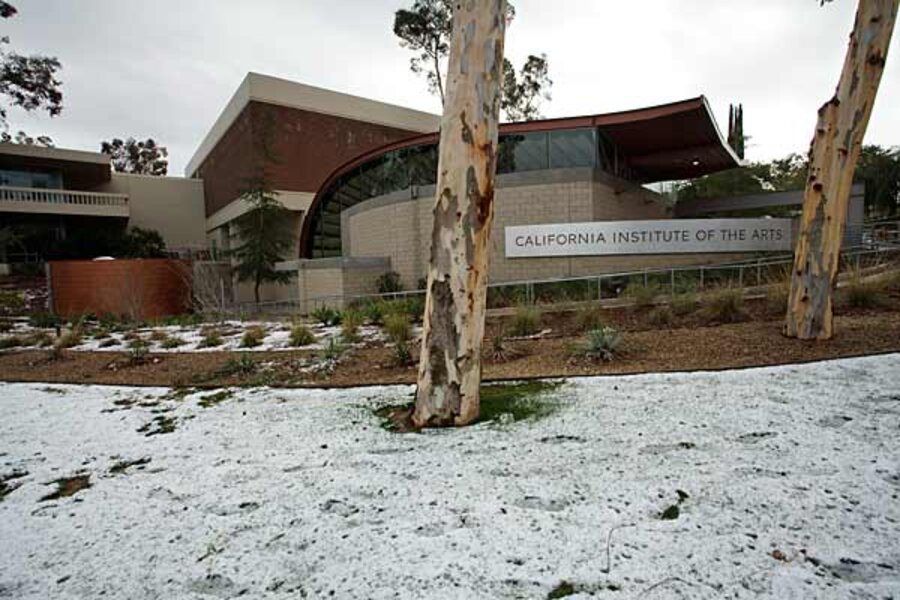Grapevine closed by snow: playtime near L.A., but tough work on I-5
Loading...
| Los Angeles
Even as delighted California Institute of the Arts students were building snowmen Monday from the five inches of snow that fell on their Valencia campus north of Los Angeles, the California Highway Patrol was working to reopen a vital section of Interstate 5, the state’s main north-south artery that was closed by heavy snow and high winds midafternoon Sunday.
According to Highway Patrol public information officer John Lutz, the closure is not unusual, but reopening the “Grapevine,” a key windswept 40-mile stretch that runs south from Bakersfield toward the Mexican border, is particularly tricky.
While the corridor is vital to state and international commerce, Mr. Lutz points out, the stretch of highway is lacking in vital services and represents a real threat to any cars or trucks that may get mired in mud or snow.
“There is no food and no gas, and the road is difficult to traverse because of the ice,” Lutz says. But, he adds, the Highway Patrol regards this short-term closure as routine: “This happens nearly every year.”
Less common, though, are the snow flurries that have hit the greater Los Angeles area at record low elevations, such as in the Santa Clarita Valley where Cal Arts is nestled.
As the snow began falling Sunday afternoon, says public affairs coordinator Denise Thatt, she and her Santa Clarita neighbors began gathering outside to enjoy and record the unfamiliar white stuff falling from the normally well-above-freezing California sky.
“My neighbors built snowmen,” she says. Noting how much more involved her get-out-the-door routine was this morning. “It was so much more difficult to get all the coats and scarves and warm clothes,” she says, adding, “now I really understand just how hard it is for people on the East Coast to deal with snow on a regular basis.” She herself has no children, but says with a laugh, “it would be so much harder with kids, I can hardly imagine.”
The unusual chill is part of a larger cycle, says National Weather Service meteorologist Ryan Kittell. Californians are familiar with the El Nino/La Nina weather patterns that alternate between wet and dry winters, depending on the equatorial ocean temperatures.
Warmer waters tend to drive rain into California coasts while the colder temperatures of La Nina tend to produce dry winters. The weather pattern this winter, points out Mr. Kittell, is a cold La Nina, although an “unusually wet” one.
In December alone, he points out, Los Angeles received about 10 inches of rain. In a normal year, the city receives approximately 15 inches total. “So, we’re way ahead,” he adds.
As to whether or not this cold wet pattern implies any larger trends in the overall phenomenon of global warming, David Easterling, a climatologist at the National Oceanic and Atmospheric Administration in North Carolina, points out that even if the planet is gradually warming, “that does not mean we won’t have regular climate events like snow and rain.”
Placing the current cold snap from Florida to New York and Los Angeles in this bigger picture, he also points out that cold weather in one spot means there is unusually warm weather somewhere else. While Angelenos may be throwing snowballs and hauling out their warmest clothes, “Canada is having some unusually warm weather.”
Warm is relative, he is quick to add. In this case, he says, “it might be like 12 degrees somewhere up in the Canadian Yukon, but you have to realize it’s normally 40 degrees below zero.”
The scramble to deal with extreme weather from coast to coast is a cautionary moment, says David Hales, president of College of the Atlantic in Bar Harbor, Maine. Even in the most developed countries, he says via email, “we are unprepared to deal with the disruptive consequences of the extremes of weather – extremes which are fully consistent with projections based on very conservative models of the effects of global heating."





